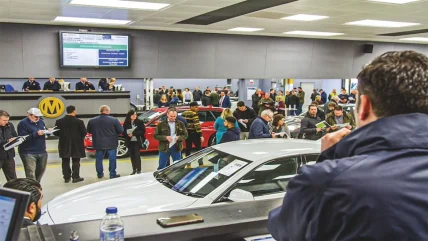
Anyone remotely connected to the automotive industry must have been living under a rock if they failed to notice that new car supply had been on the low side. Three-and-a-bit years after the pandemic’s onset, that issue has started to improve, albeit on a manufacturer-by-manufacturer basis.
It does not take a mathematician to spot that the used car market’s typical three-year/60,000-mile ex-fleet fodder will unlikely be in abundance for a while – and it was not exactly populous before Covid. According to Startline Motor Finance’s May Used Car Tracker, supply was the number one concern for 84% of respondents – the highest level since the monthly survey’s inception, but the recent production slowdown is not the only reason for stunted supply.
The used car parc is being nibbled from all angles, rental and leasing companies, and manufacturers – on top of the usual franchised and independent dealers. Each wants a piece, and each takes a bite out of the relatively few available vehicles.
Auction companies have told us, off the record, that household-name rental firms have been acquiring used vehicles at auction for use on their fleets for some time. This was a direct response to the lack of new cars and vans, as manufacturers poured what little they had into the more lucrative retail market. Fleets – also less profitable per unit – were lumped in with rental.
“There was this significant shift towards the private customer, because you were paying full retail [price], if not more, for a new car,” says Philip Nothard, insight and strategy director at Cox Automotive, “[rental firms] said, ‘I still need product because I’ve got ageing profiles [and] I’ve got heavy SMR costs,’ so they went into the used vehicle market. In 2021 and 2022, rental buyers, particularly, were competitors to dealers in the used car marketplace.”
He admits that some rental companies have eased off from buying used cars, as manufacturers have crept back to big fleet buyers, but others are said to have sneered at the OEMs’ retreat to the corporate market.
“Some of the operators that were cut off are saying, ‘oh, you want me now, then, do you?” adds Nothard, “well, I don’t really need you, because I’ve now found an area in the [used] market and I can manage my fleet differently’.”
Then there is manufacturers’ increasing moves from traditional franchised dealer models to agency, which involves the OEM keeping vehicles on its balance sheet and controlling the price, instead of transferring them to the dealer as they do under the franchise model. The dealer is paid a fixed fee by the manufacturer to sell each car and cannot set its own price. The idea is that the manufacturer has greater say over sales and pricing is more consistent, in line with wider online buying trends, but it is a financial risk for the OEM and controversial among retailers. Many OEMs have adopted agency overseas and plenty are planning it for the UK, while Mercedes made it official in January (it has not been plain sailing; UK sales were down 8.38% year-to-date as of the end of April).
New cars are the focus of the agency model, and many manufacturers say it will not interfere with used sales, but not everyone agrees. Tim Abbott, former MD of BMW UK and now head of region at INEOS Automotive, was an early and successful pioneer of the format when he headed up BMW’s South African arm (it became South Africa’s biggest premium brand in April 2021, toppling Mercedes).
Speaking to Business Car 18 months after BMW SA’s January 2020 move to agency – he described the manufacturer’s approach to second-hand cars under the model: “Used cars up to one year old are now controlled [by BMW] and every used car is priced [by BMW] and made available in a portal to every dealer. We went back to what I call the traditional step model of a proper used car – a genuine demonstrator probably around 10% cheaper than a new car. What you’ve got is much more clean business around demonstrators, which were the main feed for cars under a year old, plus our own company car fleet. We deemed [cars older than one year] to be dealer business.”
Yet, Nothard believes manufacturers will encroach on used cars as the agency model progresses, upping the demand for second-hand models even further.
“The OEMs have got to take control of that 0-12, 0-24, and eventually that 0-36-month used car space,” he says, “you can’t have this transparency of pricing without taking control of some of it. How do they manage their buybacks, their management cars, their courtesy, their demonstrators as used cars if they are not in control of them?”
Abbott predicted as much in 2021: “There’s been a lot of discussion around ‘should we get more involved in used cars two, three, four years old?’ I think natural forces will take place, because. our central team would actively canvas customers and say things like, ‘I see you’ve got a four-year-old deal on a 3 Series. You’ve gone into positive equity after three years, so you can put a deposit down on a new car a year early – would you like to do that?’ So you naturally control that used car market without realising it.”
Last but not least are the contract hire firms which, while not exactly shopping for used cars, are keen on a second or even a third crack of the whip with leases and direct-to-consumer used car sales. It is not a new idea, but previous iterations have had limited success and scale. Leaseplan, for example, tried it with its CarNext brand, which still exists in Europe but closed in the UK in 2020 after a 2018 launch and significant losses. Arval kicked off a similar scheme, known as Autoselect, in 2020. It started small, with less than 200 cars advertised on the site, and, when we checked, the firm said it was “going well” and had seen “a steady increase – month-on-month rather than a drastic spike” over the previous six months. Average re-leased cars are 2.9 years old with just under 24,000 miles on the clock; EVs currently account for around 20% of stock, which is expected to rise.
Nothard says interest has piqued in multi-life leases, partly from a desire to hang onto electric cars for longer. “One way of risk aversion to your depreciation is not to let it [the car] out into the open market and recycle it through a used lease. Reports are they are looking at keeping pure EVs for up to 10 years. because SMR costs are fairly low.
“However, financially, it’s not attractive [to lessees]. I can get a two-year-old Tesla for £600 a month. I can get a brand new one for not much more, if not as much as that. There’s a huge disconnect in used leasing at the minute, but lots of leasing companies are looking at it.”
Second half volumes up?
Pressures on used car supply may be increasing, but one auction company is expecting a rise in volumes in the second half of 2023. Shoreham Vehicle Auctions MD, Alex Wright, cautions that supply is intermittent and varies by manufacturer, but his advice to fleets which have recently started to renew their vehicles is to shift the used ones quickly and take advantage of strong prices, ahead of a potential softening towards the end of the year.
“Anything with an ICE engine has been a very solid market,” he says of ex-fleet models, “I would be saying sell now. Optimise your vehicle in the current market. I think vehicles that you’ve got coming off will be doing so because you’ve got a bit of [new] supply, and based on what our vendors are saying, I think that supply’s going to increase, so there’s going to be a greater amount of older vehicles coming in the market towards the end of the year, and that’s only going to push the prices down.”
Supported by:






